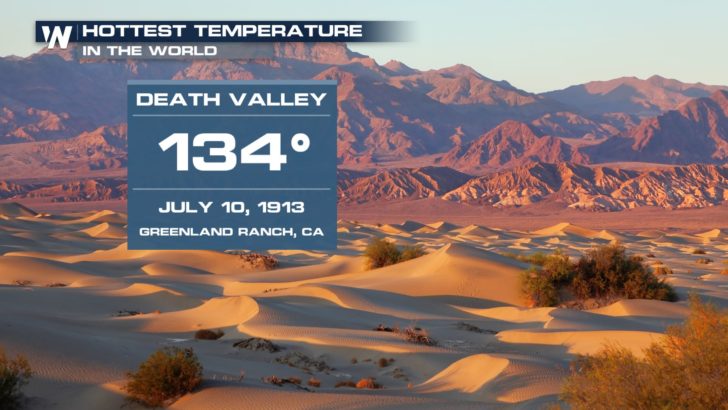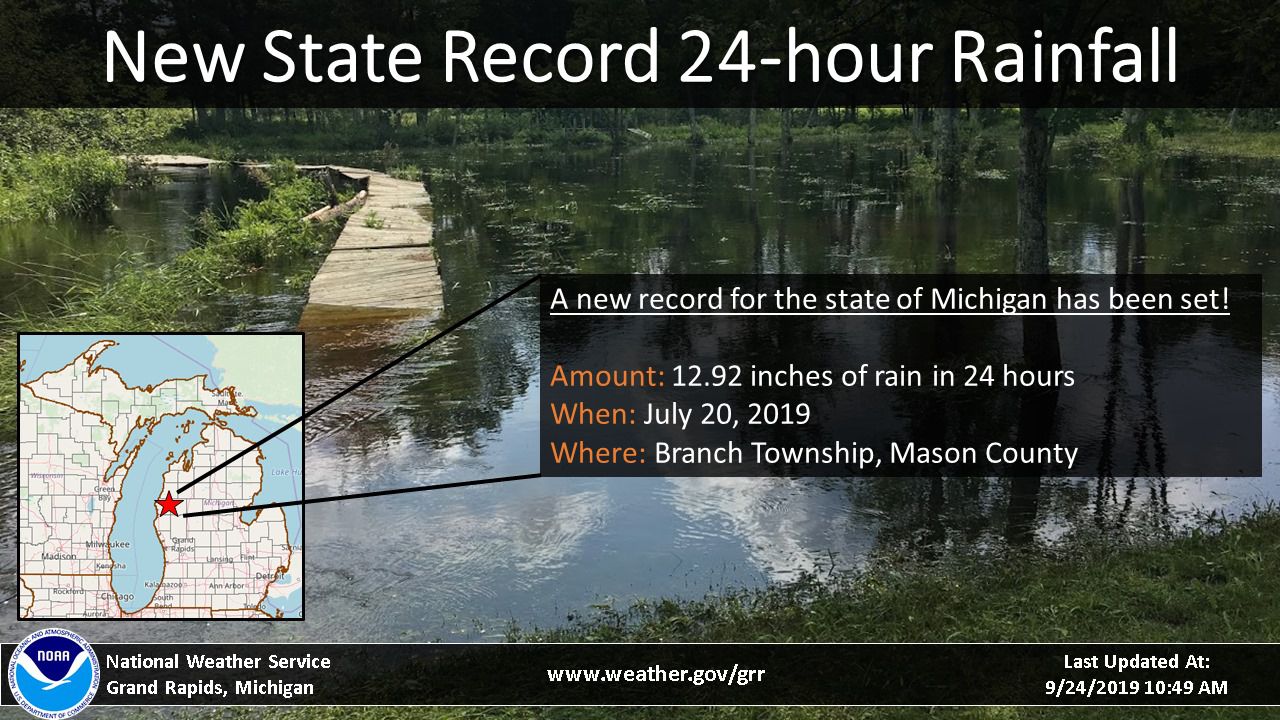Assessing Extremes: How NOAA Vets Potential Climate Records
Special Stories
5 Aug 2020 2:00 AM
[Largest hail stone recorded for weight (1.9375 lbs) and diameter (8") from July 23rd, 2010 in Vivian, South Dakota. From NWS Aberdeen]
[Written by NOAA NCEI] A supercell thunderstorm just pounded your house with hail, and one of the stones is enormous, as big as a softball. Could it be a state record?
There’s one way to find out: drop the hailstone into a plastic bag, stick it in the freezer, and contact your local National Weather Service (NWS) office. If the hailstone passes initial review, it might come up for assessment by the State Climate Extremes Committee (SCEC), led by NCEI.
Think of the SCEC as a sort of “CSI: Meteorology.” Committee members investigate claims of state climate records—temperature, winds, precipitation, and more—and either approve or reject them, with findings preserved in reports that read a bit like criminal case files.
“I really like the forensic aspect of it,” says Karin Gleason, a meteorologist with NCEI’s Monitoring Section, who manages the SCEC under the direction of the Monitoring Chief. “I like looking at every aspect of a potential record to see if there’s a weakness or a flaw somewhere in it.”
The committee grants approval to most of the proposed records that come before it, but a few are rejected. Those rejections can be contentious, but rigorous standards are crucial in fulfilling NCEI’s mission of preserving the most accurate climate data possible.
 [Photo of baseball-size hailstones from 1982. Courtesy of NOAA OAR/ERL/Wave Propagation Laboratory]
[Photo of baseball-size hailstones from 1982. Courtesy of NOAA OAR/ERL/Wave Propagation Laboratory]

 [The SCEC tracks five core climatological elements in every state: minimum and maximum temperature, 24-hour precipitation, monthly snowfall, and snow depth. Graphic courtesy of NOAA NCEI.]
[The SCEC tracks five core climatological elements in every state: minimum and maximum temperature, 24-hour precipitation, monthly snowfall, and snow depth. Graphic courtesy of NOAA NCEI.]

 [Newspapers recording the coldest temperature ever recorded in Minnesota at -60 on February 2, 1996. From Minnesota DNR, with courtesy to St. Paul Pioneer Press and Minneapolis Star Tribune]
[Newspapers recording the coldest temperature ever recorded in Minnesota at -60 on February 2, 1996. From Minnesota DNR, with courtesy to St. Paul Pioneer Press and Minneapolis Star Tribune]
 [Photo of baseball-size hailstones from 1982. Courtesy of NOAA OAR/ERL/Wave Propagation Laboratory]
[Photo of baseball-size hailstones from 1982. Courtesy of NOAA OAR/ERL/Wave Propagation Laboratory]
Defining Climate Boundaries
Why are climate extremes important? “At first blush, it's the ‘wow’ factor—knowing what the extremes are can be really exciting,” Gleason says, and might inspire young people to study science or even pursue a career in meteorology. More critically, knowledge of climate extremes helps civil engineers build infrastructure that can withstand a region’s highest winds, heaviest rain, and most extreme temperatures. When engineers design a bridge, knowledge of maximum and minimum temperatures can help them predict how much the materials might expand or contract. In addition, Earth’s climate has entered an era in which “we anticipate a lot of extremes,” Gleason says. In a warming world, for example, rainfall rates are likely to increase, producing heavier precipitation over a shorter period of time. “Knowing the boundaries of your climate system is really helpful to understanding how the climate system might be changing with time,” Gleason says.
Evaluating Claims
SCEC functions much like NCEI’s National Climate Extremes Committee, though it tends to be busier, given that the 50 states produce a large number of potential records. The committee tracks five core climatological elements—maximum and minimum temperature, 24-hour precipitation, monthly snowfall, and snow depth—for every state, as well as more than a dozen others that only some states provide. The SCEC review process begins when a potential record comes to the attention of a state climatologist or an NWS Weather Forecast Office (WFO). Officials conduct an initial review, which, depending on the type of record proposed, might involve visiting the site where it occurred to test the equipment used and take photographs. If those officials think the value might be legitimate, and it appears to be the most extreme such event on record, they convene the SCEC, an ad hoc committee of five comprising one representative from NCEI and four officials representing agencies located in the geographical area where the proposed record was measured: the state climate office, the NWS WFO, the NWS Regional Headquarters, and the Regional Climate Center. The committee examines the evidence and either accepts or rejects the record. [The SCEC tracks five core climatological elements in every state: minimum and maximum temperature, 24-hour precipitation, monthly snowfall, and snow depth. Graphic courtesy of NOAA NCEI.]
[The SCEC tracks five core climatological elements in every state: minimum and maximum temperature, 24-hour precipitation, monthly snowfall, and snow depth. Graphic courtesy of NOAA NCEI.]
Collecting Evidence
Hailstorms are among the most dramatic of weather extremes because they can cause property damage and leave behind tangible, though fragile, physical evidence—the stones themselves. Hailstone records are also democratic, because rarely are they collected by trained observers at official weather stations. “Anyone can find a record hailstone,” Gleason says. When Craig Mann found an enormous hailstone in his front yard in Walter, Alabama, on March 19, 2018, he posted photos on social media and dropped the stone into a freezer in his garage. Staffers at the NWS Huntsville office saw the photos, visited Mann, and took measurements with a tape measure and scale. A few days after that, a representative from the Insurance Institute for Business & Home Safety scanned the hailstone using three-dimensional laser imaging. The SCEC convened, reviewed the measurements and scans, confirmed the meteorological plausibility of the record—that a supercell thunderstorm had passed over the area, and that there was abundant evidence large hail had fallen—and unanimously agreed that the hailstone set the record for Alabama in four dimensions: diameter (5.38 inches), weight (9.8 ounces), volume (19.80 cubic inches), and circumference (13.75 inches).This case marked the first time measurements from a laser scan were used in an SCEC determination. The technique allows for more accurate determinations of diameter and circumference, as well as measurements for values such as volume that would otherwise be difficult to capture.
“That took hail measuring to a whole new level,” Gleason says.
Missing the Mark
Not every proposed climate extreme earns recognition as an official state record. “There have been instances that kind of broke my heart,” Gleason says. One such case involved a report of a 50.8-inch snowfall in Erie, Pennsylvania, over a 24-hour period starting on Christmas Day 2017. It was a lake-effect event, with strong winds blowing off Lake Erie, and the measurements were made by a relatively inexperienced observing team that had not yet been trained to work under such difficult conditions. The committee voted 4-1 to reject the record. “We felt the observers went out of their way to make as accurate of a measurement as possible, but some situations are just impossible,” Gleason says. “We’ve rejected more snowfall measurements than for any other element, because a heavy snowfall rate can be very hard to measure with reasonable accuracy.” Reports on both rejected and accepted extremes are archived on the SCEC website, which is searchable by state and climate element. [Newspapers recording the coldest temperature ever recorded in Minnesota at -60 on February 2, 1996. From Minnesota DNR, with courtesy to St. Paul Pioneer Press and Minneapolis Star Tribune]
[Newspapers recording the coldest temperature ever recorded in Minnesota at -60 on February 2, 1996. From Minnesota DNR, with courtesy to St. Paul Pioneer Press and Minneapolis Star Tribune]
Learning from Rejection
Rejected records, however, are not wasted time. In some cases, SCEC members can recommend that suspicious data be flagged, invalidated, and/or replaced with estimates or data from a nearby station. The authors of the Erie report worked with local NWS forecasters to recommend new techniques for measuring snow under windy conditions. Similarly, proposed rainfall records have been rejected because the rain gauge was placed too close to a sloping roof or a fencepost and therefore may have collected splashes or drips as well as rain. When these problems are exposed, the gauges can be moved to better spots. Tracking extremes, in other words, improves the quality of data collected. "I'm always trying to look for good things that can come out of even the rejections, where we can learn and get better,” Gleason says. Better measurements produce better data, and better data provide a deeper understanding of a changing climate. Edited for WeatherNation by Mace MichaelsAll Weather News
More